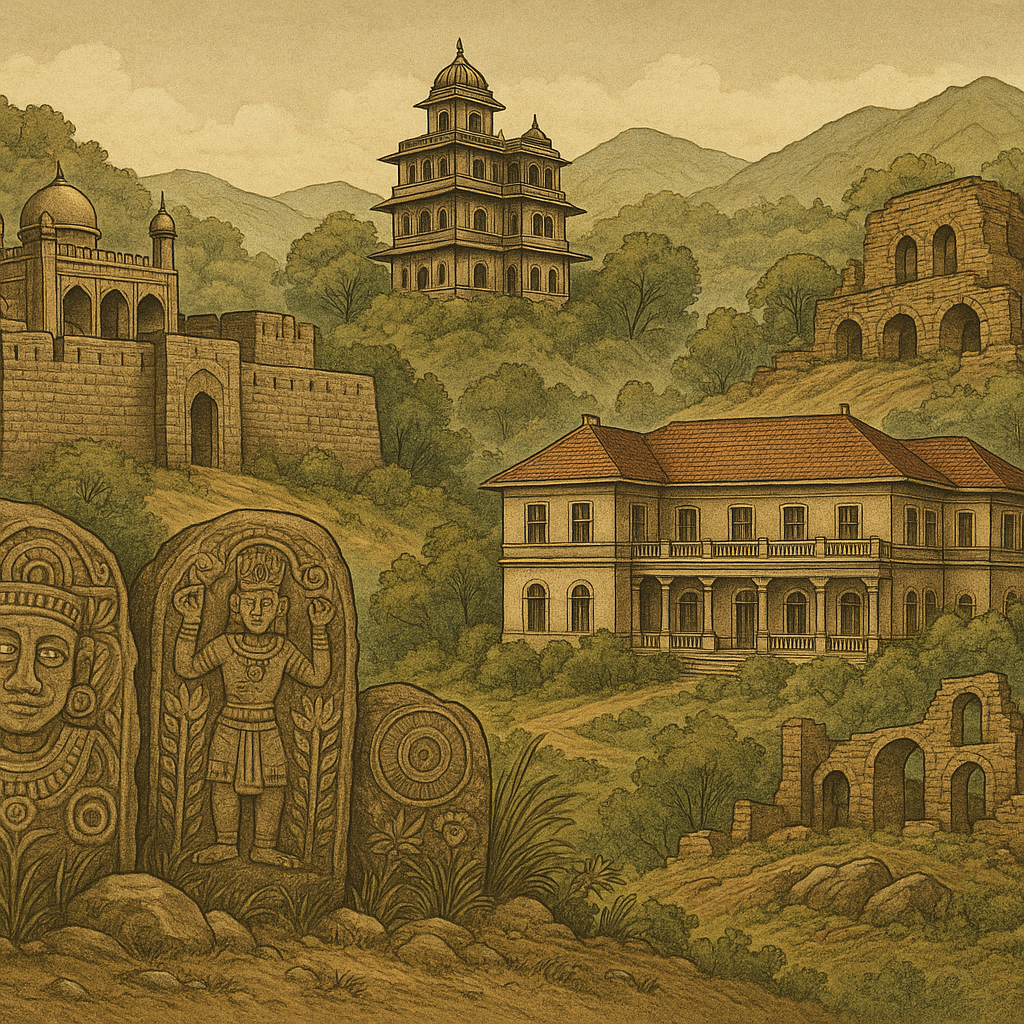Mughal Pressure and the Struggle of the Chero Kings (1627–1640)
- The Chero rulers, especially Raja Narayan Dev, were under constant pressure from the Mughal Empire during this period but successfully resisted domination.
- Narayan Dev did not submit to Mughal authority and refused asylum to Muslim attackers entering through Gaya and other northern regions.
- Despite intense Mughal efforts, Narayan Dev‘s territory, including Santhal Pargana, was never completely subdued.
- Mughal chroniclers of the time and contemporary inscriptions provide accounts of these continued resistances.
Strategic Importance of Rajmahal:
- Rajmahal was a key region where the Ganges River entered and flowed westward. It was located a short distance from Sahibganj, offering a strong military advantage.
- Due to the natural terrain and military fortifications, Rajmahal was difficult for Mughals to penetrate easily.
Mughal Campaigns and Routes:
- The Mughal forces avoided direct confrontation at Teliagarhi, instead taking a less-used, winding path via the Mor River and Dwarka River, passing through Sherpur in Birbhum district, to enter Gaur (the then-capital of Bengal).
- To defend Gaur, Bengal’s army advanced from Teliagarhi, but Sher Shah Suri’s son, Jalal Khan, seized Teliagarhi Pass.
- Bengal’s weak ruler, Sultan Mahmud Shah, surrendered to the Afghans, handing over the region from Kiul to Sankari Gali.
Conflict Between Mughals and Sher Shah (1538–1539):
- Upon learning of Sher Shah’s victories, Mughal Emperor Humayun marched toward Bengal in 1538.
- In June 1538, Sher Shah sent Jalal Khan, Haji Khan Bani, and other commanders with troops to defend Teliagarhi.
- A fierce battle occurred between advancing Mughal forces and Jalal Khan’s Afghan army.
- Jalal Khan eventually abandoned Teliagarhi, allowing Humayun to enter Bengal — though he failed to establish permanent control.
- In June 1539, Sher Shah defeated Humayun at Chausa, becoming de facto ruler of a large region stretching from Kannauj to Chunar in the west, Jharkhand hills in the south, Assam and Chittagong in the east, and Himalayas in the north.
Akbar and the Karani Dynasty (1572–1576):
- Suleiman Karani, an Afghan ruler, remained loyal to Akbar until his death in October 1572.
- His son Daud Karani declared independence and crowned himself King of Bengal.
- In response, Akbar personally marched toward Patna (3 August 1574) to suppress the rebellion.
- The Mughals captured Hajipur Fort (6 August), causing panic. Daud fled to Bengal.
- Akbar returned to Agra, while Munim Khan, his general, chased the Afghans through Surajgarh, Munger, Bhagalpur, and Kahalgaon (likely Guruandi).
- Afghans fled again without resistance; Munim Khan captured Tanda, the Bengal capital, on 25 September.
- Daud was defeated at Tukaroi near Subarnarekha River (3 March 1575) and expelled from Bengal, which then came under Mughal control.
Continued Instability (1575–1594):
- Even after this, peace was elusive in Bengal, Bihar, and Odisha.
- After Munim Khan’s death (22 October 1575), Hussain Quli Khan (titled Khan-e-Jahan) was appointed Viceroy of Bengal, with Todar Mal as his deputy.
- The Afghans resumed rebellion. Daud Khan fortified himself at Rajmahal, but Khan-e-Jahan laid siege for months.
- On 10 July 1576, additional troops and resources were sent to Khan-e-Jahan from Bihar.
- In a decisive two-day battle, Daud’s forces, including the famous general Kala Pahar, were defeated.
- Daud was executed, and his head was sent to Akbar in Agra. His cousin Junaid Karani was blown up by a cannon, and Kala Pahar was wounded and fled.
Post-War Administration and Resistance:
- After Bengal came under Mughal control, Khan-e-Jahan died on 19 December 1578, near Tanda.
- In April 1579, Muzaffar Khan Turbati became Bengal’s governor, but his rule was troubled by rebellions.
- Some Bengal rebels joined forces near Rajmahal, recapturing Teliagarhi, though only briefly.
- In 1580–81, the Mughals reconquered Bihar, and in April 1582, Khan-e-Azam was appointed governor of Bengal.
- He marched via Munger and Kahalgaon, capturing Teliagarhi on 20 March 1583, and reached Katinganj near Rajmahal.
- On 27 March, a month-long standoff ensued with rebels, involving heavy cannon and gunfire.
- On 24 April, Kala Pahar was killed, marking a decisive Mughal victory.
- This victory paved the way for the final consolidation of Bengal under Mughal control.
Rajmahal Becomes Capital (1592):
- In 1592, Rajmahal was declared the capital of Bengal by Akbar’s representative, Raja Man Singh.
- Although Sher Shah had chosen Rajmahal as an administrative center earlier, it was Man Singh who formalized its status.
- Previously, Gaur was the capital (1202–1576), except when shifted to Pandua and later Tanda.
- As the Ganges shifted west, Tanda became three miles away from the river, diminishing its strategic importance.
- Rajmahal, situated directly on the river, became the new administrative hub of Bengal.


One thought on “Mughal Pressure and Struggle of Chero Kings (1627-1640)”